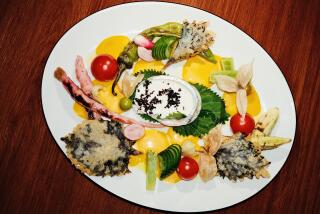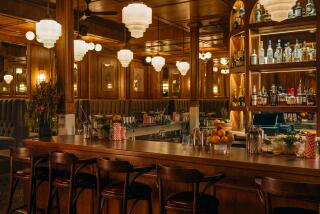A blend — or clash — of old and new at Grand Central Market
I’m an unrepentant sucker for a good, lively, mixed-use urban market filled with fresh produce, food stalls, good conversation and other assorted necessities of life.
If they rented office space at the Farmers Market at 3rd and Fairfax, I’d take a suite next to Bob’s Coffee and Doughnuts, although I’d never get anything done with all the people-watching and schmoozing opportunities. My favorite places in Seattle and Philadelphia are urban markets, and if I can be blunt, any city without a good one isn’t worth living in.
All of which is to say I’m waiting to see what comes of Los Angeles’ downtown treasure, the iconic Grand Central Market, which is undergoing a transformation that could either destroy it or revive it, depending on whom you talk to.
The changeover has been in the works for almost a year. But wander the market these days and you will see empty spaces, construction zones and a half-dozen “Coming Soon” signs, all of which suggest a tipping point in the transformation of an operation that, by the way, has benefited from public redevelopment funds.
Among the new businesses coming are DTLA Cheese, Olio Pizza, Eggslut, Oyster Gourmet and Belcampo Meat. They will join newcomers Sticky Rice Thai Street Food, Horse Thief BBQ, Valerie Market and G&B; Coffee.
For many years, the market has served primarily as a discount center, offering produce, dry goods and prepared meals to a largely working-class Latino clientele. At Chiles Secos, you can get several kinds of mole in bulk, and at Tacos a Tomas, $2.50 buys you a carnitas taco big enough to feed a family. But the gourmet cheese shop will soon be up and running, and once you start down the Brie de Meaux path, is the people’s market history?
I hope not. As it is, Los Angeles has too few places where the boundaries of race and class disappear and the city’s full profile is on public display. On Monday, I bumped into a frequent customer at Grand Central, going back to the 1990s, who put the market’s potential perfectly.
“I really see this as a bridge,” said David Gershwin, a government affairs consultant, between the “working-class people on Broadway and the corporate towers on Bunker Hill.”
But as a business model, is that a workable concept?
One vendor I spoke to has his doubts. He withheld his name for fear of angering management, but he said he believes the plan is to push out longtime vendors when leases come due, putting lots of employees out of work in the interest of trendy, gentrified commerce. He thinks that going upscale will drive up rents and prices, and scare away the discount shoppers, yet there won’t be enough new downtowners willing to subsidize locally sourced, grass-fed, organic this and that.
“Who’s going to pay for it?” said the vendor, who peered over his counter at the bargain hunters who scoured the market. “These people are not going to pay $10 for a pound of meat.”
Marc Wutschke, a downtown resident, fears the days of tomatoes for 50 cents a pound are numbered, and what is now an “exotic” locale will lose “its character and flavor.”
But such talk is nonsense, according to management, which says the character of the market is its greatest asset. And I’m told that nobody who is able to pay the rent is being forced out, but according to a spokesman, some vendors are as much as three years in arrears.
Adele Yellin, president of the development company that runs the market, told me she wants the best of the old market to blend with the new. Some of the longtime businesses are well-run, she said, citing Tomas Martinez’s taco stand, while others need some freshening up if they are going to survive. (Martinez, by the way, starts each workday by taking an employee to G&B; Coffee for a latte and croissant, a snapshot of the potential for two worlds to come together at the market.)
Rent increases are not in the works, Yellin said, but that doesn’t mean they will never happen.
“Rents do go up,” she said. “Listen, this is a business.”
Of course it is, but I’m worried about the fact that the folks behind San Francisco’s Ferry Building Marketplace have consulted on Grand Central. The historic Ferry Building is a dead-air vault and wasted opportunity, a highfalutin space without soul, grit or surprise.
Don’t worry, Yellin told me. Like her late husband, Ira, she wants the market preserved and enhanced, but she doesn’t want cute. She said she would like the now-cavernous Hill Street side to become “a living room for downtown L.A. You come here, you buy food, you hang out. A civic meeting place.”
To be perfectly honest, I’m going to go to the cheese shop when it opens, and Gourmet Oyster, not to mention the wood-fired pizza place. And I have it on good authority that the salt caramel croissants at the new Valerie are worth a trip to the market.
But I’d also like to still be able to go to Chiles Secos for prepared Oaxacan mole negro to take home. When I asked Rocio Lopez how long her business had been there, she reached for a yellowed Los Angeles Times from 1986 on the shelf behind her and showed me a photo of her father, Celestino. She said her father began working at the stall in 1970, later bought it, and used his salary to raise 15 sons and daughters, 12 of whom have worked for Grand Central vendors at one time or another.
Lopez greeted a longtime customer, Armando Gutierrez, a blind man who takes the bus from Highland Park to do his shopping at Grand Central, buying roasted peanuts and mole poblano at Chiles Secos. We talked about changes at the market and I asked Lopez if she thinks she will be able to keep her business open.
“I hope so,” she said.
Me too.
More to Read
Sign up for Essential California
The most important California stories and recommendations in your inbox every morning.
You may occasionally receive promotional content from the Los Angeles Times.











